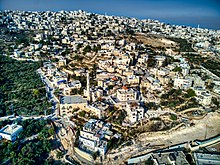Umm Tuba
[4] An archaeological excavation uncovered at least three royal seal impressions dating from the reign of Hezekiah, King of Judah (eighth century BCE).
[7] Impressive remains of a Byzantine-era monastery have been found, which has been taken as proof that Umm Tuba was the site of “Metofa”, a place mentioned in the writings of Church elders in the Byzantine period.
They paid a fixed tax-rate of 33,3 % on agricultural products, including wheat, barley, olives, vines or fruit trees, and goats or beehives; a total of 7,500 Akçe.
[10] In 1883, the PEF's Survey of Western Palestine (SWP) described the village as "an ancient site with bell-mouthed cisterns and ruins of modern buildings.
[20] The Wingate Charitable Trust has established a joint Jewish-Arab project in which fifth and sixth graders from Umm Tuba and Kiryat HaYovel study science together.
[21] Through the Abraham Project at the Bible Lands Museum in Givat Ram, fourth graders from Umm Tuba meet with their Jewish peers to learn about their common ancestor, Abraham/Ibrahim.
[23] In 2008, Prof. Tamar Rapoport and Afnan Masarwah of the Hebrew University of Jerusalem presented their research on changing perspectives of motherhood, children and family relationships among women in Umm Tuba.

